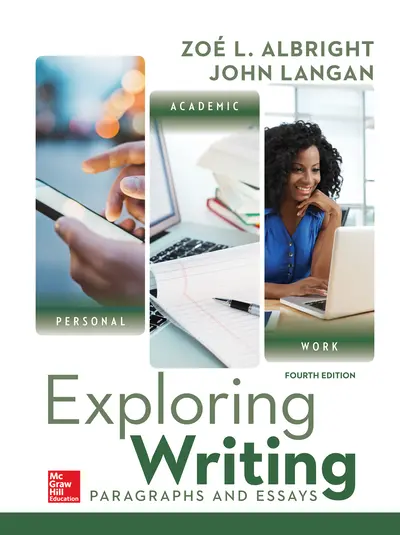My Account Details

ISBN10: 007353479X | ISBN13: 9780073534794

* The estimated amount of time this product will be on the market is based on a number of factors, including faculty input to instructional design and the prior revision cycle and updates to academic research-which typically results in a revision cycle ranging from every two to four years for this product. Pricing subject to change at any time.
Instructor Information
Quick Actions (Only for Validated Instructor Accounts):
Now in its 4th edition, Exploring Writing emphasizes writing skills and process. By referring to a set of four skills for effective writing, Exploring Writing encourages new writers to see writing as a skill that can be learned and a process that must be explored. Langan identifies the four skills, or bases, for effective writing. Unity: Present a clearly-stated point or topic sentence, and make sure that all other information in the paragraph or essay reinforces that point. Support: Support the points with specific evidence, and plenty of it. Coherence: Organize and connect supporting evidence so that paragraphs and essays transition smoothly from one bit of supporting information to the next. Sentence skills: Revise and edit so that sentences are error-free for clearer and more effective communication. The four bases are essential to effective writing, whether it be a narrative paragraph, a cover letter for a job application, or an essay assignment. Updated with 11 new readings (including works by Carol Dweck and Ta-Nehisi Coates), new content on literary analysis, and updated student examples, Exploring Writing engages students in the writing process and facilitates their development as academic and professional writers. This title is also available as a low-cost rental option.
TABLE OF CONTENTS
PART 1 Writing: Skills and Process 2
1. An Introduction to Writing 4
2. The Writing Process 25
PART 2 Basic Principles of Effective Writing 58
3. The First and Second Steps in Writing 60
4. The Third and Fourth Steps in Writing 90
5. Four Bases for Revising Writing 126
PART 3 Paragraph Development 162
6. Exemplification 164
7. Narration 175
8. Description 184
9. Process 195
10. Cause and/or Effect 206
11. Comparison and/or Contrast 216
12. Definition 230
13. Division-Classification 240
14. Argument 251
PART 4 Essay Development 270
15. Introduction to Essay Development 272
16. Writing the Essay 285
17. Introductions, Conclusions, and Titles 315
18. Patterns of Essay Development 329
PART 5 Research-Based Writing 368
19. Information Literacy 370
20. Working with Sources 385
21. Writing a Research Paper 417
PART 6 Handbook of Sentence Skills 434
SECTION I Grammar 436
22. Subjects and Verbs 437
23. Sentence Sense 442
24. Fragments 445
25. Run-Ons 457
26. Regular and Irregular Verbs 468
27. Subject–Verb Agreement 476
28. More about Verbs 481
29. Pronoun Agreement and Reference 485
30. Pronoun Types 490
31. Adjectives and Adverbs 496
32. Misplaced and Dangling Modifiers 501
SECTION II Mechanics 511
33. Capital Letters 512
34. Numbers and Abbreviations 519
SECTION III Punctuation 524
35. Apostrophe 525
36. Quotation Marks 531
37. Comma 538
38. Other Punctuation Marks 546
SECTION IV Word Use 552
39. Commonly Confused Words 553
40. Effective Word Choice 563
SECTION V Tests 570
41. Editing Tests 571
PART 7 Readings for Writers 588
INTRODUCTION TO THE
READINGS 590
GOALS AND VALUES 594
EDUCATION AND LEARNING 646
CHALLENGING SOCIETY 679
Index 717
Need support? We're here to help - Get real-world support and resources every step of the way.